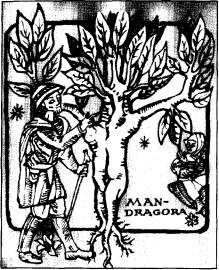A Brief Account of Mandrakery
Through the Ages
In ancient times, the
mandrake plant was believed to have magical powers. The forked root,
resembling the human female form, was thought to be in the power of dark
earth spirits. It was believed that the mandrake could be uprooted
safely only in the moonlight, after appropriate prayer and ritual: one
drew three circles around the plant with the tip of a willow wand then a
black dog was attached to the plant by a cord. Human hands were not to
come in contact with the plant. It was thought that as the mandrake was
pulled from the ground, it uttered a shriek that killed or made mad
those who did not block their ears against it. After the plant had been
freed from the earth, it was used for beneficent purposes.
As far
back as Genesis, the mandrake root was thought to be a powerful
aphrodisiac, as well as an aid to fertility and of great value in
facilitating childbirth. In the bible
story of Rachel and Leah, Rachel
tried for years to conceive and felt great despair when she wasn't able.
She moaned to her husband: "Give me children or else I die!"
She finally ate mandrakes and ended up con ceiving.
The mandrake plant also has large, dark green leaves and orange-red
colored, fleshy berries. The ancient Hebrews called the mandrake dudiam,
"love apple" because of the plant's fruit and its reputation
for increasing fertility and sexual arousal. In medieval times, the
plant was referred to as "Satan's apples"
and thought to cause madness. The mandrake root was said to be a chief ingredient in witches brews and it is the
most commonly cited example of the abuse of medicinal plants by those
obsessed with magical rites and orgiastic rituals with which some
hallucinogenic and narcotic herbs became closely associated in the dark
ages.
ceiving.
The mandrake plant also has large, dark green leaves and orange-red
colored, fleshy berries. The ancient Hebrews called the mandrake dudiam,
"love apple" because of the plant's fruit and its reputation
for increasing fertility and sexual arousal. In medieval times, the
plant was referred to as "Satan's apples"
and thought to cause madness. The mandrake root was said to be a chief ingredient in witches brews and it is the
most commonly cited example of the abuse of medicinal plants by those
obsessed with magical rites and orgiastic rituals with which some
hallucinogenic and narcotic herbs became closely associated in the dark
ages.
Today,
modern science has revealed that the mandrake root falls into the
classification of an anodyne, like belladonna and coca leaves. Two of the
active chemical components in the mandrake root are scopolamine
and atropine, both powerful depressants.
The mandrake is also exceptionally rich in mandragorine,
a powerful narcotic and hyp-
notic. Its primary effects
are as a depressant, hallucinogen
and hypnotic. It is easy to see how aphrodisiacal
powers as well as the danger of madness or death might well be
attributed to it. It is also an emetic and a purgative, causing the
stomach to contract. Perhaps this is the origin of its use as an aid to childbearing.
But in any case, direct ingestion
of the root is not recommended: The effect of the mandrake is extremely
unpredictable and very toxic.